Read Shadows in the Vineyard.
Wonderful storytelling so far. It reminds me vividly of my first trip there a few years ago. I will never forget the feeling of awe and excitement as we drove the Route de Grand Crus and stopped to gaze at all the famous vineyards. I remember being almost giddy and close to tears as we sat on the wall of Romanee Conti sipping a glass of wine. It sounds weird to say this but I had an almost religious sensation sweep over me. It was an unforgettable experience that I urge all Burgundy lovers to have. Keep the stories coming!
Great report. You’re a good writer.
Quiet streets? Noticed this too mid-afternoon in the villages around Baden Baden…and the windows all shuttered up!
Third installment: I love the smell of Corton in the morning.
Let’s just say our first tasting trip didn’t turn out quite as planned. We made a wrong turn on RN74 and were running late for a 9 a.m. appointment at Domaine Taupenot Merme in Morey St. Denis. We called ahead and let a woman on the line know that we’d be 15 minutes late. She assured us it would be no problem.
When we arrived at the stately looking estate, we quickly hustled inside and one of the office workers ushered us into a side conference room. Bursting in, we were met with the perplexed gaze of owner-winemaker Romain Taupenot, who was leading a tasting for about 8 or so sober-faced people around a wooden table.
Not knowing our audience, Greg explained in French that we were sorry for being tardy and to accept our apologies. Romain, seemingly genuinely perplexed by our presence, responded in English that he had no idea who we were. Greg assured him that his contact at Corney & Barrow had confirmed our appointment for the morning. Obviously flustered, Romain apologized and basically said there was no more room at the inn. The other guests sat there stone faced, tasting notebooks in hand, staring at us as if they were prosecuting attorneys at a coroner’s inquest. The poor bastards, I could hear them thinking. Ouch. We slunk out of there with our tails between our legs completely embarrassed.
We sat there in our car in the Taupenot driveway for about five minutes, laughing our asses off about how well that went and what to do next. Then we saw a figure emerge from the doorway, a Brit who had connections with Corney somehow and had made calls and smoothed things over with Romain. We were shown back inside again to awkward laughter and were invited to sit on some saggy red couches to the side, sort of like the kids table at Thanksgiving. Romain was totally gracious and apologetic and started pouring us wines mid-flight from the 2014 and 2015 vintage.
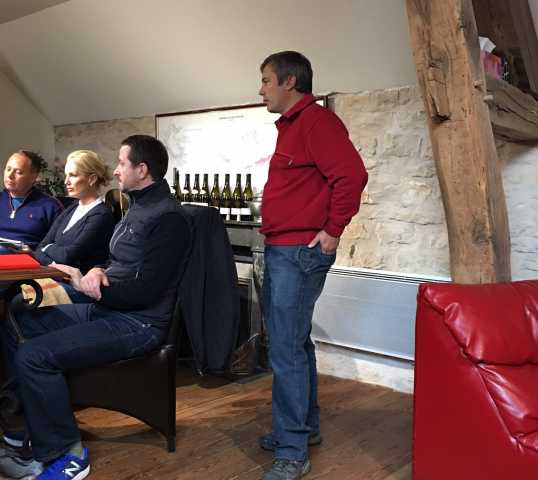
We started off with some Morey St Denis 1er cru Riotte and then moved into some of the Grand Crus from Charmes, Mazoyeres and Corton Rognet. I had never had these wines before but Greg is a buyer and said the house is a great GC value play in the mode of Drouhin-Laroze or Damoy. To be fair, I wasn’t in the best frame of mind for the tasting given all the previous kerfuffle – so take my notes with a grain of salt. Taken as a whole, the wines display a well-made directness. They aren’t over-manipulated or over-extracted and they show plump, unadulterated fruit – but underpinned with plenty of bass note and structure. They aren’t woody (I think 50% new oak for GC and 25% village) and they seem to be holding something in reserve – kind of a cool elegance. The 2015s seemed more surly and brooding at this point, while the 2014s danced with red fruits and spice.
Romain said he was extremely pleased with both vintages and said each has a place in a cellar, with the 2014 providing more immediate pleasure. He said conditions were stellar for the 2015 growing season and his main concern was keeping alcohol levels low and acids sufficient to keep the wines from becoming blowsy or overripe. Like others on this trip, he pulled out a 2008 Charmes Chambertin for the group to try. There were those airy cherry notes and bright acidity that I prize in good ‘08s, but plenty of structure still. A serious Charmes with more to unfold. I don’t see these wines in L.A. but I’m glad to have been introduced to them. They have village wines in Gevery, Morey and Chambolle as well.
Once our tasting was over, Romain chatted with us in the driveway and couldn’t have been more gracious about the mixup earlier. He started in finance and now runs operations with his sister Virginie, the seventh generation of the family to care for these wines. He has an air of quiet determination mixed with a contemplative streak. I offered him a gift of some California black mission figs and wished him well. And off we went. (Lesson learned: Always confirm an appointment, especially if someone else has made it for you!)
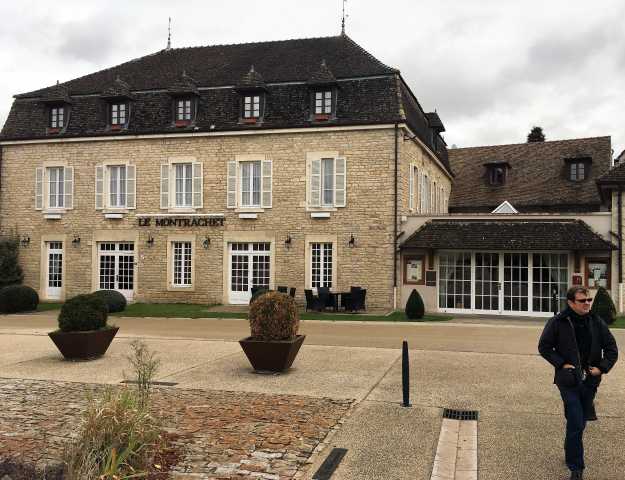
Not having had breakfast, we were famished and looked forward to our lunch in Puligny Montrachet, at the Michelin-starred Le Montrachet. First, I have to say that the village of Puligny Montrachet was my hands-down winner for most picturesque town during our visit. The restaurant itself anchors one side of a village square that is utterly charming, well-manicured and inviting. That feeling spilled over to the restaurant, which is bright and airy and exudes refinement without being stuffy. There is a great gallery of photos on the walls featuring portraits of the top winemakers in the region in their cellars. (You can geek out on that during a trip to the restroom.)
The food is classic French but with a clean, light modern edge to it. Relaxed service managed by a crew of young and enthusiastic food lovers. I had the lunch menu with a deeply flavored parsnip soup with delicate sliced mushrooms and quenelles of locally caught pike in a simple Lyonnaise sauce of crayfish, wine, herbs and brandy. And all for under 40 euro in a Michelin restaurant! To drink? Puligny Montrachet of course – a Sauzet village wine from 2010.
One other note about this restaurant: It simply had some of the best butter I’ve ever had in my life. Paired with the restaurant-baked chewy rolls and a bit of sea salt, the butter could’ve been my entire meal. I could have sat in that elegant room happily eating bread and butter, drinking the Sauzet and taking in the dappled sunlight streaming in from French windows and been completely satisfied.
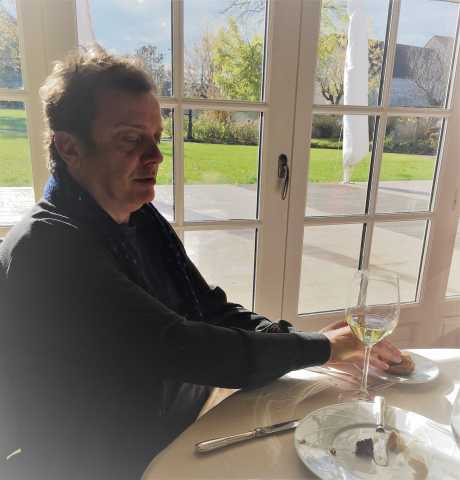
After our two-hour meal, we had a very short ride over to the cellars of Francois Carillon, one of my favorite producers in Puligny. We were greeted by one of the assistant winemakers (I’m sorry I didn’t catch his name), who showed us around the bottling facility as well as the caves and fermentation tanks. We tried some 1er cru 2015s from tank, and the 2014s from bottle – Champs Gains, then Folatieres and then Combottes.
Speaking only French, our guide explained that for this house the 2014s are viewed as more vin de garde wines for extending aging while the 2015s are destined to be open-knit pleasure bombs, or gourmandaise in style. He explained that the former Louis Carillon property has been split into two parcels managed by Francois and his brother. If we understood correctly, he seemed to indicate that Francois’ wines are a bit more forward, while brother Jacques’ wines are a bit more reserved. (Note: We could’ve gotten this wrong.)
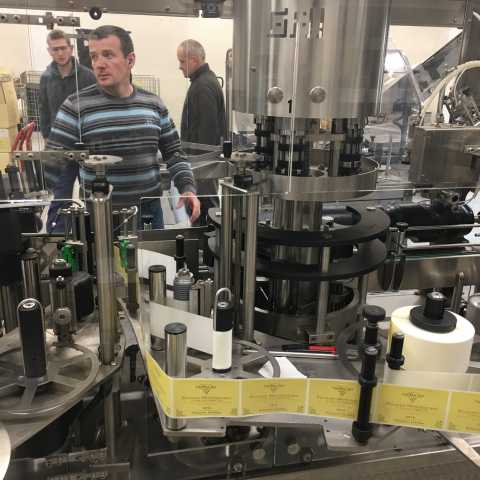
Maybe because they are so flashy and precocious, I totally dug the 2015s. The Combottes had this screaming spicy floral nose that reminded me of that luscious apricot thing with well-made Viognier. The Combottes also seemed like a hypothetical blend of the more structured Folatieres and the more round Champs Gains. It’s a wine I will be buying by the case for near-term indulgence. I also had my first-ever St. Aubin red here – a 2015 village wine that was fruity, upfront but laced with subtle graphite notes like a decent Beaujolais cru wine. They also had a tiny amount of Chevalier Montrachet in a small tank that looked like a pony keg but we didn’t merit a taste. If I understand correctly, the domaine has lost access to these grapes moving forward.
It had been a long day – sigh – so back to Beaune for a siesta …
Next: Driving the backroads of Clos St. Jacques in a beat-up VW van with Gilbert Varoilles
I have had confirmed appointments cancelled because the vignerons just didn’t feel like it that day–Ramonet and Hudelot-Noëllat. (Probably hung over in Ramonet’s case.) Sure pissed us off! But it is a magical place.
That happened to me once - with Jacky Truchot! In fairness to him, it was late June 2003 and in the middle of the heat wave and he was exhausted from being in the field all day.
Not only is this one of the best written and informative posts I have read here, but this will get me there on my next trip. Thank you.
Fourth installment: A loyal dog, a VW van and a cheeky Dujac
Pulling into the driveway of Domaine des Varoilles in Gevrey Chambertin, I had fairly modest expectations. After all, I had never heard of the domaine, let alone tasted their wines. A light drizzle fell as we stood near the tasting room waiting for our host. A degustation sign beckoned thirsty tourists to come inside. I remained a bit skeptical.
Then a ruddy gentlemen greeted us happily in French, exuding a hale-and-hearty demeanor. Owner-operator Gilbert Hammel seemed overjoyed at not having to speak English. He urged us to get inside a dark blue VW Camper van so he could show us his vineyards. With the reassuring sound of car wheels crunching on a gravel path, we headed off to the hills of Gevrey.
We crisscrossed all over the commune taking a look at his varied parcels of village and 1er cru land spread over the town. It’s an interesting mix of monopoles and shared land. He described in detail the strengths and challenges of each plot, as if candidly describing the attributes of his children. Always fighting erosion here. Such grace here because of the particularly stony soil. (Later he would show us these big Plexiglas tubes filled with soil and dirt from each of his sites – a sort of core sample so you could better understand the terroir of each parcel – very instructive!)
He drove us on some backdoor route past the fabled Clos St. Jacques vineyards to get to the Varoilles 1er cru site he owns. He explained, if we translated property, that this swath of hillside across the Cote de Saint Jacques used to be categorized as Grand Cru but is now all 1er Cru (including Estournelles, Lavaux, etc.) He said that he still considers his monopole Varoilles vineyard to be worthy of GC status. But what would you expect him to say? ![]()
Perched on a narrow cart path hard against the forest, the rain starting to come down harder, I wondered about the safety of the high-profile van high up on the slope. But Gilbert radiates confidence and assuredness, peppered with those wonderful phlegmatic Gallic touches. He’d listen to Greg and Martin talk about wine in French and punctuate their thoughts occasionally with a reassuring sing-song of D’accord and Bien Sur. Sitting in the back of the van, with no idea what his running dialogue was about, I took an immediate liking to Gilbert. This is a cool dude, I thought. (Doing some reading later at home, I uncovered a report that said he’s a Swiss businessman who bought in about two decades ago – smart investment!)
Our tour over, we headed back to the ranch, with Gilbert pointing out little nuggets about the village – an 12th century monastery/church that had been purchased by Hong Kong money and then left untouched for years, the impressive castle of the Duc de Bourgogne (Gilbert seemed to intimate that Claude Dugat was inhabiting or using it?)
Returning to the estate, we did a quick tour of the caves and then headed to the tasting room to try the wines – joined by Gilbert’s attentive Wamareiner. We had a sampling of the monopole and shared 1er crus from 2014-15, plus some special cuvees and a GC from Charmes Chambertin. The wines matched Gilbert’s personality – open-knit, honest, direct. These aren’t wines to overthink or try to extract special nuances from. They are rustic in the best sense of the word, to be enjoyed at the table, with food and family. For some reason, his wines brought me back to one of the first vignerons in Burgundy that caught my fancy – the Ecard bottlings from the '90s.
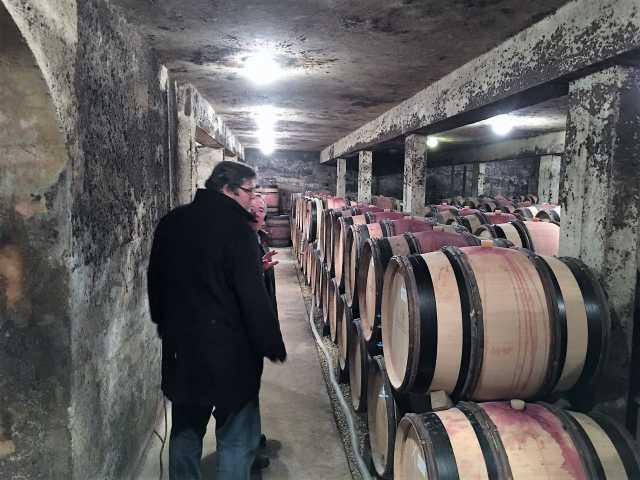
That’s not to say his wines are simple or four-square by any means. The Varoilles vineyard monopole resonated with me best – with its high-toned aromas, flinty structure and succulent dark red cherry notes. Gilbert makes a premium cuvee that sees more new wood and longer time in cask. It’s a deeper, more intense wine but I preferred the basic bottling. Broken record time – when we asked if Gilbert could open one of his older wines, he disappeared and came back with, wait for it, a 2008. His Charmes Chambertin had a hint of burnt rubber in the nose, but the palate definitely showed a more refined but tightly wound element that spoke of a GC vineyard.
But I preferred the ebullience of his monopoles and wound up buying a case to ship home of his old-vine 2010 Varoilles vineyard 1er cru – a steal at 40 euro each! (I will think of that vineyard and the VW perched on the steep slope every time I open a bottle over the next 10 years.)
As we were wrapping up our visit, an adorable, elegant older couple visiting from Paris dropped by the tasting room to sample the wares. The well-dressed wife adored that we were American, enabling her to practice her very good boarding school-style English. They sampled about four wines, picked their favorite one and within 10 minutes had left with a case to go. Efficient! It was a cozy afternoon in the rain, a room filled with good cheer, a loyal dog and honest wines.
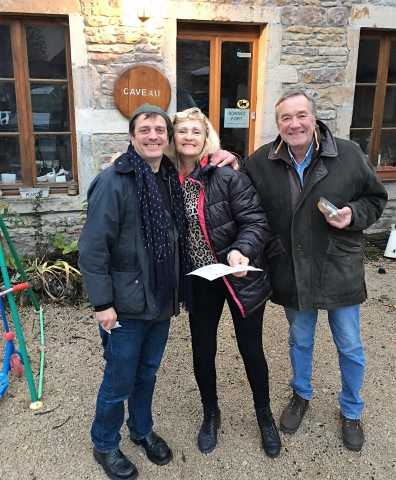
For lunch, we sauntered over to Bistrot Lucien, adjoining the luxe Rotisserie du Chambertin hotel. It’s a comfortable spot, with dark wood and stone accents but plenty of sunlight. When we walked in, a cook smiled at us as he flipped over a big chunk of entrecote grilling over a wood flame in an open hearth. I knew we were in business! The room was booked with several groups of Chinese and British wine geeks I had already seen around Beaune. But a mix of locals – chic businesswomen and smartly dressed, middle-aged couples – rounded out the room.
Once again, I opted for the super reasonable fixed lunch menu, with a butternut squash soup and a pork loin grilled over that flame, sliced with a simple reduction sauce and just-picked mushrooms. The soup, which sounded modest, turned out to be one of my favorite dishes of the trip. It tasted of autumn, with the deep flavor of butternut squash, crème fraiche, tiny perfectly formed croutons, and just a few small strips of what looked like jambon persille. Swoon.
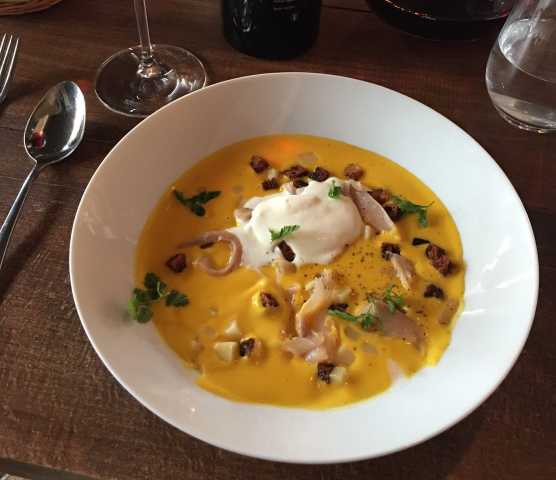
We found a bottle of Dujac Morey St Denis 2002 for less than $100 on the list. Spicy, stemmy, with lots of blackberry/cassis notes, the wine was nicely resolved with a highly glossy mouthfeel. Very cheeky as Jeremy Holmes might put it. Just perfect with the pork dish. A bottle of 2009 Denis Mortet old vine village Gevrey Chambertin followed. Accompanied with a full plate of local cheeses selected by our adorable waitress, the wine seemed just a tad young and structured, but with an appealing mix of boysenberries and sandalwood. It felt great to be sitting in the warm room on a gloomy day with decades-long friends, the remnants of a wood fire dying down, enjoying the last sips of a thoughtful wine in the very village where it was born.
Next: A long visit with the cagey master of Corton – Jean-Charles le Bault de la Morinière of Bonneau du Martray
Editor’s note: I am traveling this weekend, so look for final (!) installment on Monday.
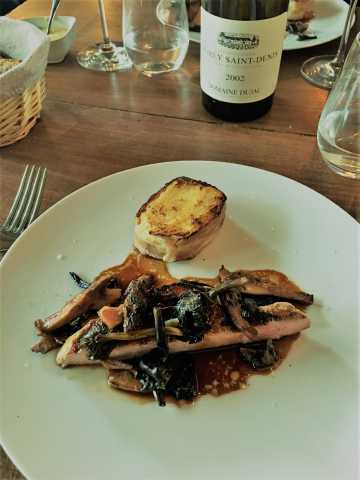
Bistrot Lucien is such a great lunch spot. They had this incredible poached egg in white burgundy that one was one of the very best egg dishes I’ve ever had.
Thanks for the report Matthew. The food pics are making me hungry.
Which is the wine map you downloaded?
Last installment – Vintage Corton Charlie, vintage Hermes scarves … and a seafood platter to die for!
The intermediary who arranged our visit to Bonneau du Martray had emailed us with the explicit instructions not to be late. We made a wrong turn on the way to the village of Pernand Vergelesses but I was able to course correct on the fly and we got to the domaine with about a minute to spare. I’m glad we did, because the master of the house – Jean-Charles le Baut de la Moriniere - was waiting for us promptly in an outside foyer.
Dressed casually in a North Face fleece and khakis, Charles nonetheless conveyed an air of sophistication and precision. With his bushy white eyebrows, piercing eyes and polished English, he comes off equal parts diplomat-professor-vigneron.
Standing on the entryway, he eyed us in a friendly but wary way and asked us a number of questions about our trip and our interest in his wines. Greg told him that he had just bought a large parcel of his wines from 2013 – and with a smile Charles said he had already confirmed that before our arrival. He had received a detailed report on Greg’s past buying activity that morning, he told us with a chuckle. He had done his homework on us!
That would become a theme in our two-hour visit – study and analysis. Charles clearly likes to be guided by the best-available data/information and he appears to be a voracious student of the past. He knows his history – both local and international. You can tell he doesn’t make decisions lightly, and that he carefully weighs all the options before acting. It’s also clear that he likes things done his way when it comes to wine, and that he has very detailed reasons for his choices – be it a decision to filter or not, or what kind of char he wants on his barrels.
I guess we passed inspection. After about 10 minutes of friendly grilling, he escorted us down some stairs to his tasting room. He briefly described the history of the estate and his family, showed us a number of maps of the region and talked about the unique qualities of his prime vineyards on the Corton hillside. (On the drive in, we had passed his vines and I had been immediately struck how they face west as opposed to all the other Grand Cru vineyards we had seen on our trip.)
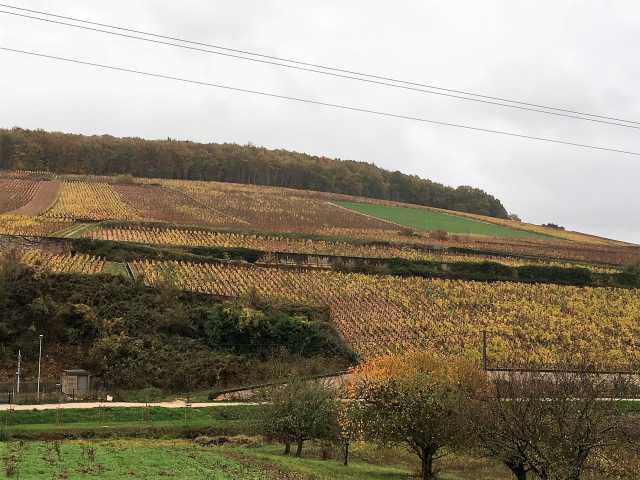
About 90% of his production is Corton Charlemagne, with the remaining 10% a red Corton. I don’t think any of the red makes it Stateside, at least not through normal distribution channels.
He spent a lot of time describing how the estate shifted to biodynamic farming and the reasons for it – both from an environmental and economic point of view. He said that biodynamic and organic winemaking has become a bit of a marketing hook these days but he chooses not to include his practices on the label. He seems to feel that it’s the right thing for the wine and the land and that what’s in the bottle should be able to speak for itself. He said that monoculture obviously presents challenges and he is constantly tinkering to leave the land in better shape for generations to come. He genuinely seemed committed to this idea of stewardship – that he is merely tending to amazing vines that passed onto him and that he will someday pass onto other members of the family.
Then we walked over to his immaculate cellars, which just smelled rich and alive with beautifully crafted and tended-to barrels. He told us how he makes his tonnelier crazy with his back-and-forth emails and perfectionist demands – but he said he’s paying the bills so he wants it done his way. In another nod to history, he described how he asks for thin strips of chestnut saplings to be affixed to the side of the barrels. It costs more but the barrels look better, and it’s the way things have always been done.
We talked at length about his winemaking philosophy. Not surprisingly, he said his wines show well young but that only time will reveal the pedigree, breeding and complexity that come from ideally situated Grand Cru vineyards. He said that he will always be an advocate for light filtering/fining as the visual appeal of his wines are as important as any other element. He said he wants people to hold his Corton Charlie up to the light and have it glimmer and reflect as if they were looking at a jewel.
I also talked to him about stem inclusion being a hot trend in some circles of California winemaking. He was curious about what stems added to CA wines, but made it clear that stems worked for some producers and terroirs in Burgundy but not most.
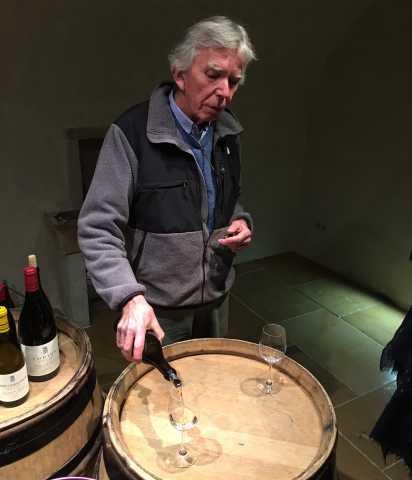
OK, enough talking. Let’s drink some Grand Cru wine! (It is worth noting, if I’m not mistaken, that he is the only domaine in Burgundy that makes wine exclusively from Grand Cru vineyards.)
Charles poured us red and white from 2014 and 2015. The Corton Charlies all showed beautifully, with that lemon curd meets minerals meets steely backbone that I love in these wines. There’s that hard-to-describe mix of density/heaviness/gravity that is still weightless. Like some kind of dwarf star pulling you in toward some compact ball of energy that still allows a halo of light and lightness around it. (Sorry that may sound like Dennis Hopper in “Apocalypse Now” but you get the idea!)
As expected, the 2015 was more lifted and floral and open as if batting its eyelashes at me. The 2014 seemed more compacted, with more stuffing for the long haul. My personal preference if I were buying would be the 2015 for its seemingly more immediate charms. The 2014 is more of a bet on what’s to come – not always a sure thing in white Burgundy! To show how his wines will evolve in the near-term, Charles graciously opened a 2008 Corton Charlemagne for us. This was a wow wine for me. It had that creamy mouthfeel you get in well-aged CCs, but peppered with cool, rocky notes. Such an elegant and balanced wine.
At this point, we casually got into a conversation about aging his wines. I didn’t say the word first, but premature oxidation popped up. I know Bonneau du Martray is a poster child for premox to some, but to be honest I just don’t have the experience with his wines to grill him on it. He said he could only speak to his wines, and that the subject warrants attention and careful study. He said rather than react herky-jerky to the latest theories and trends, he has been conducting controlled studies in house for the past 7 or 8 years with various closures – screwcap, Diam, etc. He is doing this privately and when he has an adequate information he will act if needed. Some might argue that it’s time for action in Burgundy rather than more studies. But, as I noted, Charles seems to follow his own path and in his own time.
Another interesting example of his natural caution. He explained that Japan is an important market for him and he has spent decades reading about its history and understanding how culture and interpersonal relationships in the business world works there. He said that China is obviously a huge potential market but he has consciously decided not to explore opportunities there until he has a better grasp on its business culture and its history. He told me he is currently reading histories and reminded me that France and China had a period of extended collaboration in the 1400s. He seemed pleased that there was some history to build on as he explored what the Chinese market could mean for his business.
I offered that in my home of L.A. that we also find ourselves trying to sort out what an influx of money from China might mean for our historical treasure – Hollywood. In the same way that wine is a driving cultural force and main export product in France, the entertainment industry shapes life in the States and is our dominant export. Now the Chinese are pouring money into the industry and even contemplating buying half of Paramount Studios. Questions arise naturally in both Burgundy and Hollywood about what this means for the future … He nodded thoughtfully at my analogy, gave me a small smile, and offered that time will tell.
Thrilled but slightly drained from our involved visit, I looked forward to lunch at Le Charlemagne, a modernish restaurant that afforded gorgeous views of the Grand Cru vineyards in Corton. I’m not sure, but I think we could’ve been staring directly up the hill at Charles’ vines as we ate our meal. The décor has that zen, slate gray minimalist vibe that seems vaguely Japanese. Waiters scurried about, dressed in odd uniforms of rolled-up jeans, checked red shirts and suspenders that recalls either the Log Jam ride at Disneyland or a Rough Trade record store in London.
The menu had many gastronomique permutations and concepts, but fortunately we also could choose from two simple menus for lunch – Mer or Terre. Two of us opted for the sea, centered by a delicious cod dish. Cod can be a bit generic, but the presentation and cooking was exactly on point. There was a bit of gastronomic foam, but in this case it worked. We scored a great old vine 2011 St. Aubin 1er cru from Lamy to go with it. We would also order a 2013 PYCM Chassagne Montrachet Baudines. Boy, these were night and day wines – finesse vs. power … the Lamy all air, florals and crisp apple, the PYCM all lime zest and granite dust.
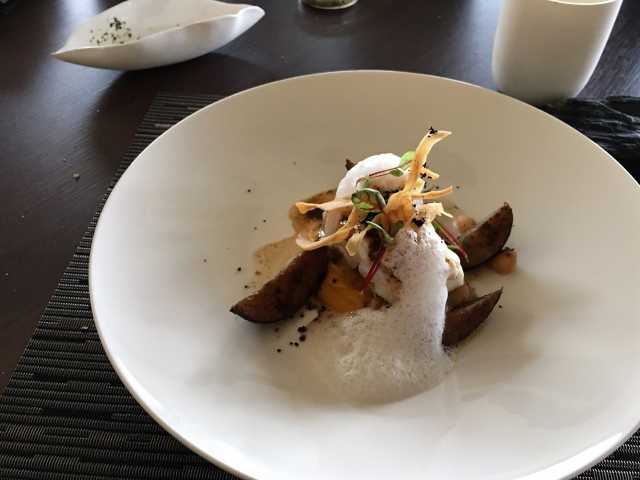
After a few strong coffees and lingering conversation, we made plans for our final stop of the day – a wine shop on the outskirts of Beaune that had been recommended to us. Mon Millesime carries the latest vintages from some of the best producers, but looking at the prices it seemed like I could source the same wines back at home at comparable prices. Kinda meh. But the real action is downstairs in their cellar area.
There are no steals to be found, but it’s an amazing collection of wines they have sourced from local cellars. There are cobwebs, dust and dampened labels – many from producers dating back to the ‘30s. It’s kind of like wandering through the shelves of a beloved used bookstore, evoking a time gone by. You feel the urge to purchase more out of nostalgia than true need. We bought a bottle of 1983 Corton Renardes from Michael Gaunoux for less than $200, thinking we’d open it for dinner on our last night in Beaune. I also purchased a magnum of Chambolle Musigny Charmes from Patrice Rion from 1998 – a producer and vintage I’ve had luck with in the past.
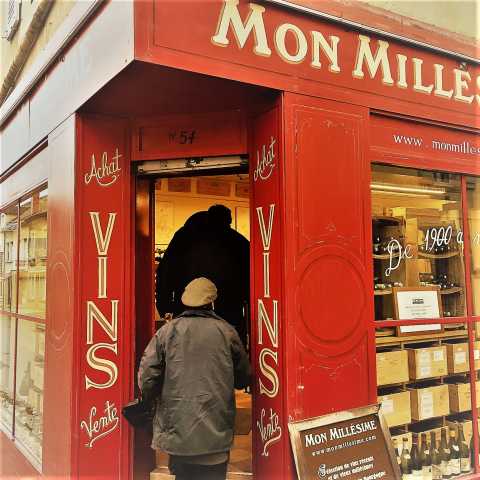
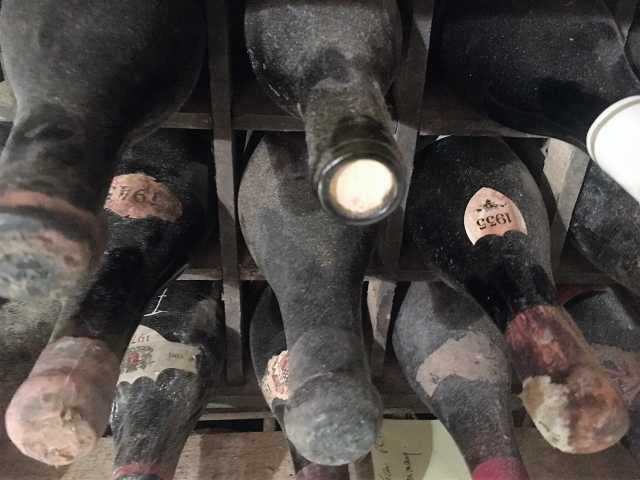
We had our final meal at Ma Cuisine, and I pulled a mini-bonehead rookie move by bringing the older Gaunoux with us. Pierre greeted us at the door and quicky grabbed my bottle and said, “Oh this must be for me. Thank you!” Later when I asked if he could open the wine, after already purchasing and consuming several other bottles, he demurred and said as a matter of principle he never lets anyone bring wine into his restaurant, saying it wouldn’t be fair to the vintners of the wine he does carry. No biggie. He was kind enough to praise our purchase though, noting that he had opened and thoroughly enjoyed an older Corton Renardes from the Gaunoux estate (1947!) at last year’s Hospice de Beaune proceedings. (We had to make do with a 2010 bottle of Meo Vosne Romanee Chaumes – yum.)
By this point, I think we were all a bit fried from five days of indulgence and called it an early night. The next morning before heading to the train station for the train to Lyons, then Paris for the trip home, I spotted some vintage Hermes scarves in the window of a local antique store. For my wife, this is like finding a dusty bottle of Roumier Chambolle Musigny tucked into a forgotten corner of an old cellar. I chose an aquamarine and silver scarf from the ‘60s (in original orange box!) with a kind of space-age abstract motif. Total score. It’s a great feeling to find just the right gift for a wife who indulges my silly wine obsession and always gives me the freedom to roam, be it surfing or wine tasting.
I shared most of my tips in the preamble to this travelogue. But just a few final thoughts:
If you’ve ever thought about going to Burgundy, just do it. I’ve read that experiences, not objects, give you the most lasting pleasure in life. The memories of time well spent with good friends will resonate much longer than the short-lived rush of acquiring an object. This ranked as one of my favorite trips in my life … right up there with an excursion to Botswana and Zambia 10 years ago. Burgundy, like the plains of Africa, will thrill your senses and give you a visceral sense of our ancestral connection to land.
Second, keep an open mind. At first, I was a bit bummed that we weren’t able to book visits with all the trophy producers that I collect – Rousseau, Dujac, et al. But wherever we went, I had such a blast visiting with such a varied and motley cast of characters. Maybe it was confirmation bias, but when I tasted their wines they reflected their personalities as much as the terroir of their vines – the cerebral Romain Taupenot, the hearty Gilbert Hammel, the aristrocratic Jean-Charles le Bault de la Moriniere. I guarantee that no matter whom you visit, you will learn something new about wine, have a laugh and gain a deeper appreciation for the life-affirming qualities of turning grapes into wine.
And one last shot of food porn – the seafood platter at Wepler in Paris. Oooh la la – the briniest oysters you’ve ever had and the sweetest shrimp flown in super fresh from the Brittany coast.
Life is short. Eat it up.
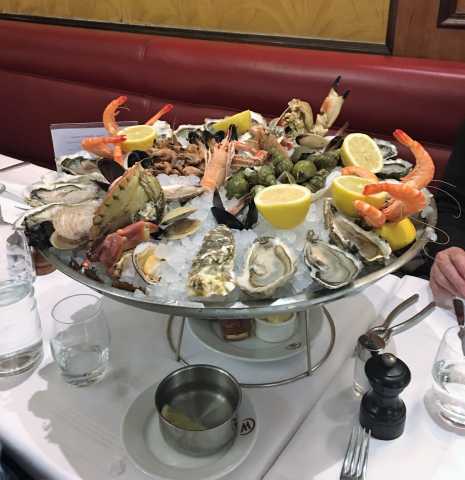
It’s called Burg Map
The Ma Cuisine guy didn’t return your wine?
We have found what you did - that most of the stores in Beaune do not have great prices, but that you sometimes can find older stuff there that you cannot find in the US. There is one store right on the Place Carnot in Beaune that has a very good selection of wines, including a good bit of Hudelot-Noellat, but still the prices are not that cheap.
The best prices we have found in Burgundy is buying directly when you visit growers, but more and more when you visit really good domaines they tell you they have no wine to sell.
A second source for pretty good prices (although not as good in my experience as at domaines) is at Caveaus in various towns that carry wines from local domaines there. For example on our recent visit, we found very good prices on 2014 Ramonet at http://www.caveaudechassagne.com/ They have a good assortment of wines from wineries Chassagne, and, they ship to the US. On a prior trip, we had good luck at the Caveau in Morey St. Denis.
Also, in Beaune, at Drouhin they sell older Drouhin wines at decent prices. A big plus is that you know how the wines have been stored. You can do similarly at Jadot, which is on the road to Savigny les Beaune.
Bravo! Thank you so much for the outstanding travelogue. You have inspired me to attempt to make the trip to the holy land, hopefully within the next year or two. I plan to try some of the restaurants you have mentioned here. Thanks again!
Fantastic enthusiasm
Thanks Matthew
Yes, he did, as you can see from photo below. He was just messing with us. I wound up packing it in my luggage and taking it home, where I will let it settle down for a few weeks. Nice fill and color, huh? ![]() Will report back.
Will report back.
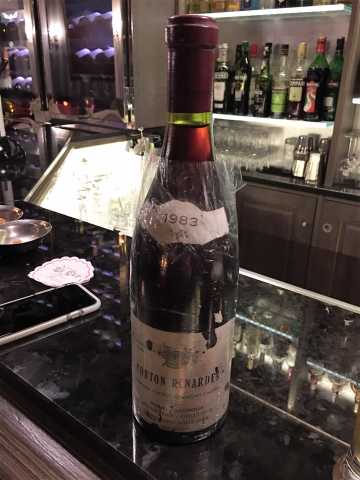
And finally here is an image of the author at the source of one his favorite wines – de Vogue’s parcel of Bonnes Mares.
Thanks to all for reading and the kind comments!
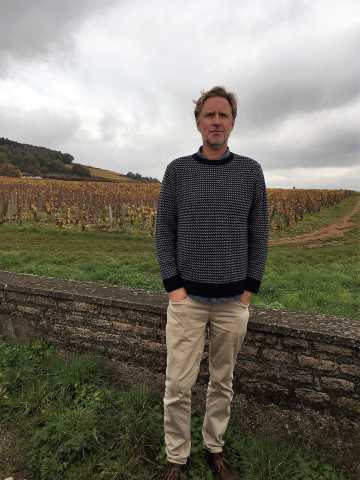
Matthew,
Really enjoyable read. Thanks for posting this. Brings back memories of our trip to Beaune seemingly eons ago, and makes me want to go again.
Cheers,
Doug